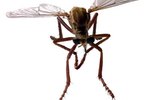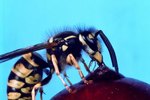
Although found worldwide in zoos and science labs, hissing cockroaches are native only to Madagascar. This species is sometimes referred to as giant cockroaches because they can be up to 3 inches in length and can be up to an inch wide. Because of their large size and other unique characteristics, hissing cockroaches have been studied extensively; researchers have noted a number of adaptations that make them unique among insects, including their reproduction methods and hissing.
Sexual Dimorphism
One adaptation of the hissing cockroach is the sexual dimorphism found between males and females of the species. Males have large bumps that look like horns; females have smaller versions of these horns. The difference in size between the horns makes sex determination easier. In males, these bumps are used to fight with other males for mates and to defend their territory. Females also have smoother antennae while the males’ antennae are bushy. Additionally, only males are considered aggressive.
Hissing Sound
The distinct hissing made by these cockroaches is another adaptation. Males and females have a second spiracle in their abdomens. Spiracles in other insects are used only for breathing, but these cockroaches can force air through these ports to create a hissing sound. The most commonly heard of the hisses is the alarm hiss, which alerts other cockroaches in their colony about potential danger. The hissing is also used while these cockroaches fight or mate.
Ovoviviparous Females
Unlike most cockroaches, the hissing species is ovoviviparous, meaning the females give birth to live young. The female creates a cocoon attached to her body where she incubates her eggs. When the eggs hatch, she pushes out the live nymphs, which appear to be smaller versions of mature hissing cockroaches. Up to 60 nymphs can be produced by a single hissing cockroach female at a time. The nymph will go through six different moltings before reaching maturity.
Non-Pest Status
Although most people in the United States view cockroaches as pests, only about 1 percent of all species actually live in human homes. The rest, including the hissing cockroach, live in the wild and have adapted to their specific environments. These hissing cockroaches live on the forest floors of Madagascar so they are used to humid climates, warm temperatures and a diet consisting primarily of fruits and plant matter. Hissing cockroaches are regularly raised in classrooms and by enthusiasts.
References
- Encyclopedia of Life: Madagascar Giant Hissing Cockroach
- Oklahoma State University: Madagascar Hissing Cockroaches
- University of Kentucky: Madagascar Hissing Cockroaches
- National Geographic: Madagascar Hissing Cockroaches
- University of Nebraska-Lincoln: Madagascar Hissing Cockroach
- Orkin.com: Madagascar Hissing Cockroach
Photo Credits
-
Jupiterimages/Photos.com/Getty Images
Writer Bio
Amy Jorgensen has ghostwritten more than 100 articles and books on raising and training animals. She is also an amateur dog trainer. She has also written more than 200 blog posts, articles, and ebooks on wedding and party planning on behalf of professionals in the field.




